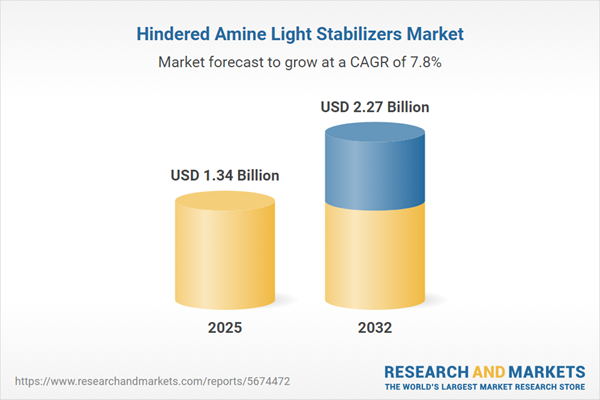Speak directly to the analyst to clarify any post sales queries you may have.
The hindered amine light stabilizers market is undergoing pivotal transformation, driven by shifting regulatory priorities, advances in additive technology, and demand for durable, high-performance materials. Senior leaders require integrated market intelligence that deciphers these changes, clarifies risk, and identifies actionable growth pathways.
Market Snapshot: Hindered Amine Light Stabilizers Market Overview
The Hindered Amine Light Stabilizers Market expanded from USD 1.25 billion in 2024 to USD 1.34 billion in 2025. It is projected to advance at a CAGR of 7.75%, reaching USD 2.27 billion by 2032. This trend highlights consistent momentum in adoption, fueled by evolving performance demands and regulatory frameworks. Industry participants are navigating increased expectations for UV protection, extended material longevity, and compliance with international standards across core end-use sectors.
Scope & Segmentation
This report offers a comprehensive strategic mapping of trends, drivers, and market structure, covering these segments and players:
- Type: Monomeric, Oligomeric, Polymeric
- Form: Granules, Liquid, Powder
- Use-Case: Antioxidants, Thermal Stabilizers, UV Stabilizers
- Application: Adhesives & Sealants, Construction Materials, Fibers & Textiles, Paints & Coatings, Plastics & Polymers including Polyethylene, Polypropylene, Polystyrene, Polyvinyl Chloride
- Region: Americas (including the United States, Canada, Mexico, Brazil, Argentina, Chile, Colombia, Peru), Europe, Middle East & Africa (including the United Kingdom, Germany, France, Russia, Italy, Spain, Netherlands, Sweden, Poland, Switzerland, United Arab Emirates, Saudi Arabia, Qatar, Turkey, Israel, South Africa, Nigeria, Egypt, Kenya), and Asia-Pacific (including China, India, Japan, Australia, South Korea, Indonesia, Thailand, Malaysia, Singapore, Taiwan)
- Key Companies: 3V Sigma S.p.A., Adeka Corporation, Arkema Group, BASF SE, Chitec Technology Co., Ltd., Clariant International Ltd., Double Bond Chemical Ind., Co., Ltd., Everlight Chemical Industrial Corporation, Everspring Chemical Co., Ltd., Fujian Disheng Technology Co., Greenchemicals S.r.l., Mayzo, Inc., MPI Chemie B.V., Rianlon Corporation, SABO S.p.A., SI Group, Inc., Solvay S.A., Songwon Management AG, SUQIAN UNITECH CORP..LTD, Syensqo SA
Key Takeaways
- Oligomeric and polymeric stabilizers are rapidly taking precedence in demanding applications due to their enhanced compatibility and long-term UV resistance.
- Integrated stabilizer systems, combining UV, antioxidant, and thermal functionalities, are gaining traction as requirements for multifunctional protection intensify across automotive and architectural segments.
- Product forms such as liquid concentrates and custom masterbatches are streamlining implementation, minimizing dust exposure, and supporting leaner production flows for manufacturers.
- Strategic partnerships and co-development programs between material producers and end-users are increasingly shaping product innovation, placing an emphasis on substrate-specific engineering.
- Environmental policy shifts and regulatory scrutiny—particularly around VOCs, extractables, and sustainable sourcing—are driving the industry toward cleaner synthesis and lower-impact manufacturing methods.
- Leading providers leverage global production footprints to balance supply continuity, with regional manufacturing supporting resilience against logistics disruption and trade policy changes.
Tariff Impact
Recent United States tariffs on imported stabilizer components have altered global supply chains and pricing models. Many companies are repositioning through local production optimization, regional manufacturing partnerships, and supply base diversification to alleviate tariff-driven cost pressures and bolster market access. These adjustments may strengthen long-term supply chain resilience and enhance service responsiveness in the face of evolving trade landscapes.
Methodology & Data Sources
This analysis draws on primary interviews with technical experts, procurement managers, and regulators, combined with a thorough review of patents, industry literature, and trade data. Data triangulation validates reliability, while expert workshops reinforce the accuracy of performance insights and market drivers.
Why This Report Matters
- Enables senior decision-makers to benchmark competitive positioning, evaluate innovation priorities, and navigate regulatory complexity across global regions.
- Supports strategic planning by clarifying demand drivers, risks, and untapped growth segments in hindered amine light stabilizer markets.
- Equips technical leaders with granular segmentation, technology adoption trends, and actionable recommendations for supply chain and product development strategy.
Conclusion
This report provides a detailed roadmap for leaders seeking clarity on market trends, technology shifts, and regional opportunities. Apply these insights to make evidence-based decisions and build more robust, future-ready strategies in the light stabilizers industry.
Additional Product Information:
- Purchase of this report includes 1 year online access with quarterly updates.
- This report can be updated on request. Please contact our Customer Experience team using the Ask a Question widget on our website.
Table of Contents
3. Executive Summary
4. Market Overview
7. Cumulative Impact of Artificial Intelligence 2025
Companies Mentioned
The companies profiled in this Hindered Amine Light Stabilizers market report include:- 3V Sigma S.p.A.
- Adeka Corporation
- Arkema Group
- BASF SE
- Chitec Technology Co., Ltd.
- Clariant International Ltd.
- Double Bond Chemical Ind., Co., Ltd.
- Everlight Chemical Industrial Corporation
- Everspring Chemical Co., Ltd.
- Fujian Disheng Technology Co.
- Greenchemicals S.r.l.
- Mayzo, Inc.
- MPI Chemie B.V.
- Rianlon Corporation
- SABO S.p.A.
- SI Group, Inc.
- Solvay S.A.
- Songwon Management AG
- SUQIAN UNITECH CORP.LTD
- Syensqo SA
Table Information
| Report Attribute | Details |
|---|---|
| No. of Pages | 194 |
| Published | November 2025 |
| Forecast Period | 2025 - 2032 |
| Estimated Market Value ( USD | $ 1.34 Billion |
| Forecasted Market Value ( USD | $ 2.27 Billion |
| Compound Annual Growth Rate | 7.7% |
| Regions Covered | Global |
| No. of Companies Mentioned | 21 |









